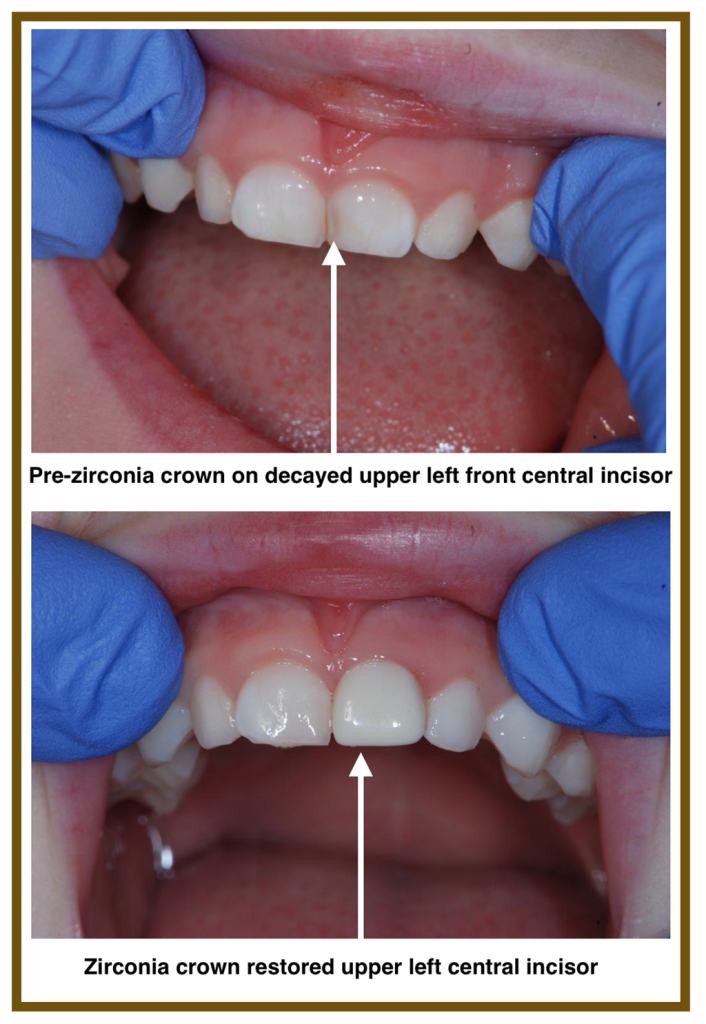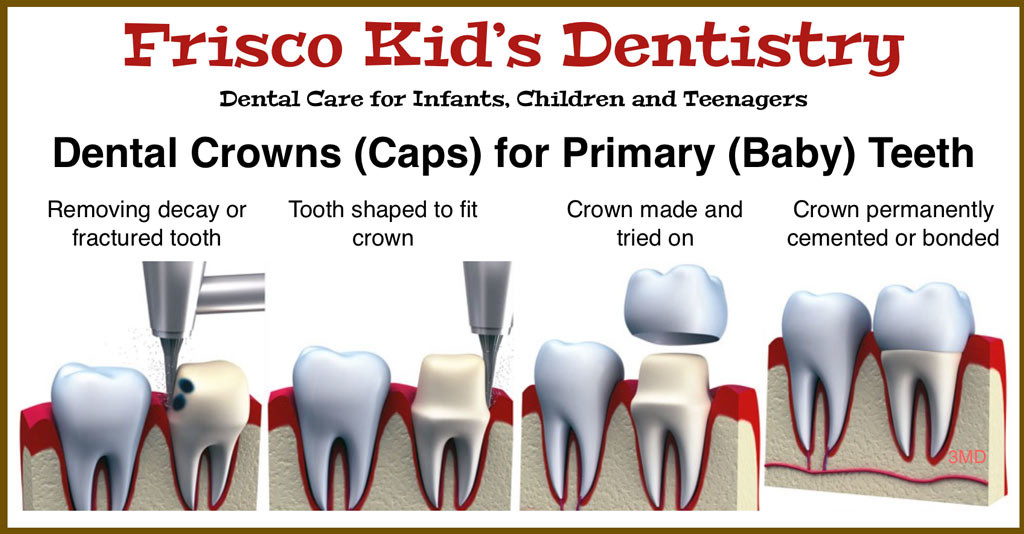Is It Necessary to Put Crowns on Baby Teeth
Dental crowns (caps) for master (baby teeth) are molar-shaped coverings cemented to the tooth for the purpose of restoring the tooth to its original shape and function.
In the practise of pediatric dentistry, it ofttimes becomes necessary to repair and restore (returning a molar to its original shape, function, and, often times, appearance) heavily decayed main teeth (babe teeth with large cavities or structural problems) with the apply of dental crowns. In the following article, nosotros will address the following frequently-asked questions regarding crowns in primary teeth:
- What is a dental crown "cap" and when are crowns necessary in primary (baby) teeth?
- Which types of crowns are available for the repair of master teeth?
- What are the steps of restoring primary teeth with a crown?
- What should I expect after my child's dental crown procedure?
What is a crown, and when are they necessary in primary teeth?
A dental crown is a tooth-shaped covering cemented to the molar for the purpose of restoring the tooth to its original shape and function. Crowns are used in pediatric dentistry for various reasons. Crowns are recommended by dentists when it is necessary repair and restore a primary (infant) tooth plant to exist extensively rust-covered (has a large cavity), a tooth fractured due to trauma, or a principal tooth which has not developed correctly.
'Extensive decay' refers to a tooth which is severely decayed with large cavities constitute on 2 or more surfaces. Severely decayed or fractured teeth are beyond the scope of repair by a filling because of the chance of the filling falling out, breaking, or wearing out resulting in the necessity of futurity dental procedures. Crowns are much more than durable than fillings, and unremarkably terminal until the infant tooth falls out at about age 12.
In improver to repairing a badly decayed tooth, It is very important to repair and restore chief teeth for the following reasons:
- Since the enamel of baby teeth is thinner than that of permanent teeth, decay can spread speedily between teeth. Crowns can exist used not only to save the decayed molar, merely can also help prevent the spread of decay and infection to other areas of the mouth or trunk.
- Crowns restore a tooth's shape, size, and function. Since one chief function of primary teeth is to hold the spacing for the permanent teeth and aid guide the permanent teeth into position, crowns are a very of import part of oral health and development.
- Crown restorations assist in the normal development of a kid's jawbone and muscles.
- Crown restorations let for proper speech development.
- Crown restorations are imperative for the chewing of food.
- Crown restorations cover the entire tooth, and therefore prevent the molar from further decay.
Which types of crowns are available for the repair of primary teeth?
There are several types of crowns available for the repair and restoration of principal teeth. The four main types are pre-formed stainless steel crowns, "Strip" or acid-etched resin crowns, veneered steel crowns, and zirconia crowns. Each blazon of crown has information technology's advantages and disadvantages and are more useful in some parts of the mouth than others.
Stainless Steel Crowns:
- Are by far the most commonly used crowns in pediatric dentistry—they are tried and true, and have been used in dentistry for over 50 years.
- Are made as metallic shells of varying sizes, and can be customized to fit any tooth
- Are perfect for molars (teeth towards the back of the mouth), as they are durable, strong, and resistant to moisture
- Are useful when at that place is decay between the teeth
- Are piece of cake to identify and by and large require only one visit to the dentist
- Are toll-effective—stainless steel crowns are the to the lowest degree expensive crowns bachelor.
Strip crowns (also known as 'acid-etched resin' or 'composite strip') :
- Consist of a clear shell which is filled with tooth-colored blended (filling) fabric and fitted over the tooth
- Once the composite material 'sets', the plastic covering is removed, leaving behind the tooth-colored material
- Are an aesthetically (cosmetically pleasing) option, and are oftentimes used for front teeth
- Are a moderately-priced option
 Veneered Steel Crowns (besides known as porcelain-fused-to-metal or resin veneer crowns):
Veneered Steel Crowns (besides known as porcelain-fused-to-metal or resin veneer crowns):
- Consist of stainless steel/nickel crown with a tooth-colored material bonded to the front, top, and sides
- Are durable
- Are aesthetically pleasing—perfect for anterior teeth
- Are a great choice for anterior (front) molar restorations
- Are also available for posterior (back) tooth restorations
- Are protective against moisture
- Require more tooth reduction than other crown preparations
- May crusade allergic reaction in children with metal allergies
White Dental Crowns:
- Are made of a hard tooth-colored textile like to ceramic
- Like stainless steel crowns, zirconia crowns are pre-made to specific sizes
- Are metal gratis
- Are virtually indestructible—stronger and more durable than natural enamel
- Are arguably the nigh aesthetically-pleasing of all crowns
- Are resistant to plaque accumulation and decay
- Are biologically-inert—exercise not initiate an allergic response when introduced to biological tissue
- Can be produced in 1 visit if the dental role has the software and hardware bachelor to practice and so
What are the steps to restoring primary teeth with a crown?
In most every dental crown procedure, there are a few universal steps. First the dentist volition numb the area effectually the molar to exist restored, put a dental dam in place, likewise as remove decay and shape the tooth to fit the crown. Unlike crowns for adults, which often require several visits to the dentist, most crowns for children can be placed in a single process. Below are the steps for most every pediatric crown procedure:
- First, the dentist will numb the surface area with a numbing gel. The gel is applied around to the gums and cheeks around the molar receiving the crown.
- Adjacent, the dentist will inject a local anesthetic to completely numb the tooth.
- Since some children experience anxiety when seeing a dentist, sometimes the child may be consciously sedated (relaxed, nevertheless completely aware of all that is going on) past one of the following methods:
- Nitrous Oxide (laughing gas): Nitrous Oxide is a gas which is mixed with oxygen and delivered through a small mask which is placed over the nose of the child. The effects are very mild, and allow the child to exist relaxed while being fully alert. Some potential issues with Nitrous Oxide include the mask feeling uncomfortable or anxiety-producing to the child. In addition, since the mask placed over the nose requires the child breathe through the nose, a child with nasal congestion may need another type of sedation.
- Medicine in the form of a syrup or pill: Different sedatives (medicines used to cause relaxation) may be administered if for some reason a child is unable to tolerate the Nitrous Oxide mask, or is highly agitated.
- An injection with a sedative medicine: This type of sedation is rare, but may exist necessary in some circumstances.
- Intravenous sedation: In situations where there is need for major restoration involving many teeth, an intravenous (medicine for relaxation through an i.v.) sedation may be used.
- So, the dentist volition place the dental dam. The dental dam is a small piece of latex or similar material used to isolate the tooth being treated. A pocket-sized hole perforated hole is placed over the molar and secured with a metallic apparatus. Dental Dams provide the following benefits:
- It protects the child'south cheeks, tongue and gums.
- It keeps the tooth isolated and dry during the procedure. For a crown restoration to be successful, it is imperative the area exist kept dry. A vacuum source is used to control moisture in the mouth beneath the dam.
- The dental dam tin can help a kid experience safe and protected during the procedure as it provides a literal and figurative barrier between the child and the dentist, and encourages cooperation with the dentist by the kid.
- The dental dam prevents a child from accidentally swallowing or aspirating (animate in) any loose material during the process.
- As the procedure continues, the dentist will get-go remove any decay using a special drill called a handpiece. The handpiece is also used to shape the tooth for optimal placement of the crown. Information technology is very important the crown fit snugly over the tooth.
- Finally, the crown will exist placed. Depending on the type of crown, the procedure may vary slightly.
- For stainless steel crowns, the dentist will chose the all-time sized crown to fit the tooth. The crown will be polished and filled with cement. The crown will then be pressed into place over the molar. One time the crown is placed on the tooth, the dentist will remove any extra cement or debris and volition rinse the kid's mouth.
- For strip crowns, the dentist volition fill a tooth-shaped plastic shell with composite (tooth-colored fabric), and will then use a special light to cure (harden) the composite. The shell will then be removed leaving a tooth-colored crown in place.
What should I expect after my kid's dental crown procedure?
It is normal for your child to experience some discomfort caused by irritation of the molar'due south pulp or soft tissue effectually the tooth for upwardly to 24 hours afterwards the process. Over the counter medicines such as acetaminophen or ibuprofen will help with the discomfort. Information technology is important to contact your child'southward dentist should the pain last longer than 24 hours.
Information technology is very important to discourage eating until your child's numbness has completely worn off. This prevents adventitious bites of the lip and/or cheek, which tin can crusade pregnant injury.
Sometimes a child may bite, chew, or suck on the numb areas of the mouth without realizing how difficult they are bitter. This can crusade severe damage. Please pay attention and discourage your child from chewing, sucking, or biting the numb areas.
If a kid mentions the tooth feels 'funny' or has trouble biting or chewing, please contact your dentist'southward office immediately as the tooth may need a chip more adjusting to achieve the platonic bite.
Finally, it is imperative to encourage brushing, flossing and rinsing at to the lowest degree twice a mean solar day to forbid healthy teeth from potential decay. A child decumbent to tooth decay may need dental checkups upward to iv times a twelvemonth. Go along your child in platonic oral health past discouraging sugary foods and drinks, encouraging regular brushing, flossing, and rinsing, and by regular dental exams.
For more information on Dental Crowns or for whatsoever questions regarding your child's oral health, delight contact our office by Online Appointment Request or call 214 618 5200.
Source: https://friscokidsdds.com/dental-crowns-caps-primary-baby-teeth/

0 Response to "Is It Necessary to Put Crowns on Baby Teeth"
Post a Comment